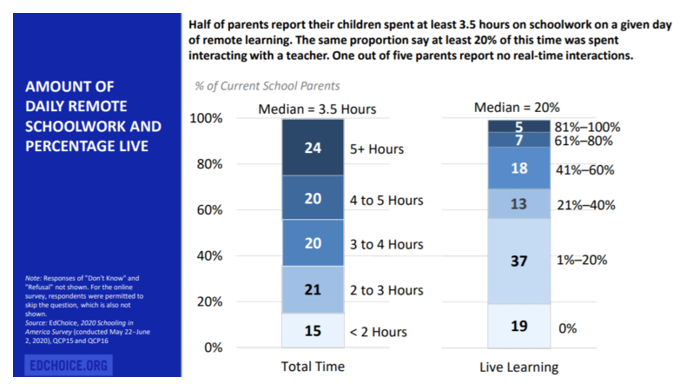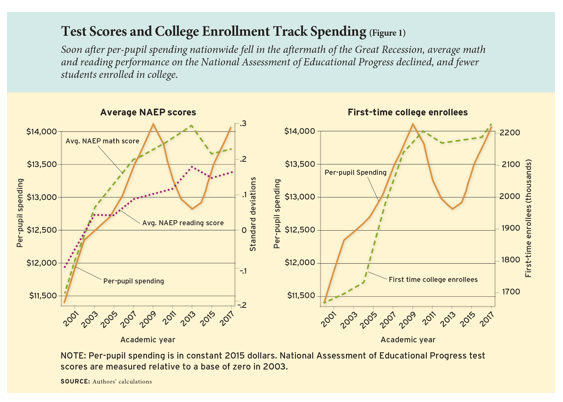
As schools continue to wrestle with reopening plans and what seems like the shortest summer break on record comes to an end, researchers have continued to churn out reports and surveys related not only to COVID-19 but to charter schools and per-pupil spending as well.
EdChoice, a school choice advocacy and research organization based in Indianapolis, released a survey on parent opinions regarding education during the pandemic.
According to the researchers, nearly 60% of parents with a child at risk for coronavirus complications said they would seek remote learning options compared to 39% of parents with a child not at risk. Additionally, Black parents were more likely to be seeking remote learning options than white parents, a finding in line with a previous survey conducted by Education Next that showed Black parents found greater satisfaction with remote learning than white parents.

A study by Ian Kingsbury from Johns Hopkins University and Robert Maranto from the University of Arkansas examined the impact of charter school regulations, finding that some regulations produce negative effects. Instead of protecting consumers, Kingsbury and Maranto concluded, bad regulations sometimes simply protect insiders.
According to the researchers, states with a high number of regulations like Texas, Ohio and Indiana saw Black- and Hispanic-run charter school applicants denied at far higher rates than white or Asian charter applicants.
“As states like California and Pennsylvania mull strengthening their charter regulatory regimes, they’d do well to take heed to ensure that people of color are stewards and not subjects of the charter schooling movement,” the researchers wrote. An Education Next article gives a good summary of the study.
Finally, a study by C. Kirabo Jackson and Cora Wigger from Northwestern University and Heyu Xiong from Case Western Reserve University, summarized in Education Next, found the Great Recession negatively impacted student achievement and college attendance. The researchers argue that a decline in education budgets because of the recession may have caused these declines.

The researchers also found that budget cuts impacted Black students more than white students and may lead to a widening of achievement gaps. They note, however, that “A particular concern is that it is changes in families’ economic circumstances due to the recession, not reductions in school spending, that account for the decline in outcomes.” Indeed, the college attendance rate began declining in 2006, years before budget cuts to per-pupil spending.
If anybody doubts the passion for educational choice in black communities, come visit Mt. Moriah Christian Fundamental School in predominantly black south St. Petersburg, Fla. and chat with its founder, Pastor Robert Ward.
Ward started the private micro-school for grades 6-8 in 2011 with three students. Now it has 56. And now it’s routinely turning away children because there are waiting lists, both for the school and for the Florida Tax Credit Scholarship for lower-income students, the largest private school choice program in America. (The scholarship is administered by nonprofits such as Step Up For Students, which hosts this blog.)
“Parents are beating on our doors to get in,” Ward said in this redefinED podcast. “We actually have stretched even our level of comfort in terms of capacity, to try to turn away as few parents as possible. But we’re very limited in our capacity.”
Dejected parents cry in the lobby, Ward said, “really with the loss of hope for their child.”
Pastor Ward is representative of a core constituency for choice that is blatantly overlooked by critics and the press. In Florida, where choice has taken root like nowhere else, there are hundreds of community leaders like Ward who represent communities of color and who wholeheartedly embrace choice. Like Ward and south St. Pete, those leaders and communities lean heavily towards the Democratic Party.
All but one of the students at Mt. Moriah school are black. All but three use state-supported choice scholarships, including 39 who use tax credit scholarships. Perhaps it’s no surprise, given that the outcomes in the school district that encompasses St. Petersburg are especially bleak for black students.
Black students in Pinellas County perform far worse on state tests than not just white students in Pinellas, but black students in every urban district in Florida. In 2018, for example, 23.9 percent of black 10th-graders in Pinellas passed the 10th grade reading test – the test they must pass to graduate – compared to a statewide average for black 10th-graders of 34.6 percent. (Statewide, 65.1 percent of white students passed. In Pinellas, 64.3 percent passed.)
The tragic trend lines go back to when schools in St. Pete were more racially integrated then they’d ever been (under a court-ordered desegregation plan), and arguably the best funded they’d even been (before the Great Recession.) They’ve persisted, Ward said, “because there’s not enough focus on what the real need is.”
“It goes back to that one-size-fits-all mentality or approach to the learning process,” Ward said. “Unfortunately, that’s just not reality. One size does not fit all. Students come from different backgrounds, different environments, different problems, different issues, that all have an effect on how we behave, how we learn, how we feel in the learning process. So I think we have to take all of that into consideration. And I think we also have to establish an environment where parents feel there’s hope.”
Also on the podcast with Pastor Ward:
 Editor's note: Julio Fuentes, president of the Hispanic Council for Reform and Educational Options, sent this email blast out earlier today.
Editor's note: Julio Fuentes, president of the Hispanic Council for Reform and Educational Options, sent this email blast out earlier today.
Governor Rick Scott made the right call in declaring "unacceptable" the race-based achievement goals outlined in the Florida Board of Education's recently released five-year strategic plan.
The Hispanic Council for Reform and Education Options (HCREO) believes that the Board's plan is not merely unacceptable; it is insulting and counterproductive to the education needs of all Florida children. Just as politics should not drive our education system, race and ethnicity should not determine the expectations we set for our students. Education reform - including the choices we give to students and their parents - is about the capacity of our youth to achieve when given the proper classroom tools and instruction.
The state's plan outlines that by 2018, 90 percent of Asian students, 88 percent of white students, 81 percent of Hispanic students and 74 percent of black students should be reading at or above grade level. For math, the goals are set at having proficiency levels of 92 percent for Asian students, 86 percent for white students, 80 percent for Hispanic students, and 74 percent for black students.
To set these different bars for students is to say, effectively, that we believe one group is capable of achieving more simply because of their skin color and ethnic background. That approach might have reigned back in the days of segregated classrooms, but it has no place in today's classrooms.
In case the Board of Education isn't aware: We are living in 2012. The nation's first black President is running for re-election. Louisiana's governor is Indian. The mayor of San Antonio, Texas made history this summer when he became the first Hispanic to give the keynote address at the Democratic National Convention. These successful leaders did not achieve because of, or in spite of, the skin color and families into which they were born. They succeeded because they had education and support from teachers and others who believed in their abilities.
Every student in every Florida classroom today deserves the same. (more…)